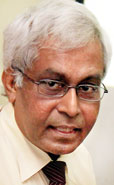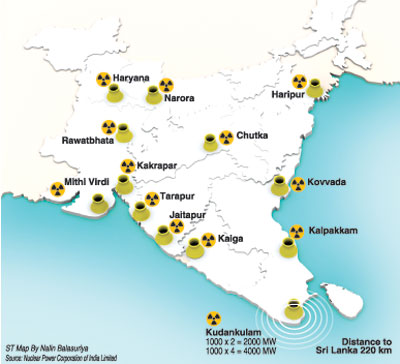Sri Lankan and Indian environment activists are concerned about the Kudankulam Nuclear Power Plant, in Tamil Nadu, which is to be commissioned within the next six weeks.
There will be a 20-day trial run of the plant’s first 1000 MW reactor, and the second 1000 MW unit is expected to be commissioned within two months of the first one.
 |
| Dr. R. L. Wijayawardana |
Indian activists and the local Kudankulam community are opposed to the nuclear power plant. There were protests in March, and more than 500 anti-nuke activists were arrested. The protesters highlighted safety issues, and pointed out that there was no proper public hearing for the plant’s Environmental Impact Assessment (EIA).
Members of the People’s Movement Against Nuclear Energy (PMANE) in India say there are serious safety problems, and they threaten to hold an indefinite fast if the plant commissioning goes ahead.
Meanwhile, the Sri Lankan Government has expressed regret that its concern about the Koodankulam nuclear plant has been misconstrued.
In a statement, Atomic Energy Authority of Sri Lanka chairman Dr. R. L. Wijayawardana says it is unfortunate that the Kudankulam nuclear plant was being used to cause tension between the two countries. He said Sri Lanka did not bring up the Kudankulam Nuclear Power Plant safety issue as retaliation against India for the way it voted at the recent UNHRC session on Sri Lanka. Dr. Wijayawardana stressed that Sri Lanka’s concerns were purely about nuclear risk.
It was the Sri Lanka Government’s responsibility to establish a Radiological Emergency Preparedness Programme, through the Sri Lanka Atomic Energy Authority (SLAEA), Dr. Wijayawardana said. Such a programme was drafted with the help of the Disaster Management Centre of Sri Lanka. The SLAEA approached the International Atomic Energy Agency (IAEA) to help boost the Radiological Emergency Preparedness Programme.
Three years ago the IAEA proposed that Sri Lanka enter into an agreement with India on radiological emergency preparedness planning. Two years ago, External Affairs authorities in Colombo wanted to discuss the management of radiological emergencies with the Indian authorities. There was no response from the Indian side, the SLAEA said.
Dr. Wijayawardana says there are three international conventions for cooperation between countries covering the potential for nuclear accidents: the Convention of Nuclear Safety, the Convention on Assistance in Case of Nuclear Accident or Radiological Emergency, and the Convention on Early Notification of a Nuclear Accident. The three conventions are applicable to both countries. A comprehensive regulatory system should be established for nuclear power. Safety was Sri Lanka’s only concern, he said.
The Convention of Nuclear Safety stipulates that any country planning to set up a nuclear plant is obliged to discuss related issues with countries in close proximity to the nuclear plant. Sri Lanka, which has not been invited for any such meetings, expects to have a bilateral agreement with India in order to work on the scientific and technical aspects, Dr. Wijayawardana said.
Meanwhile, Centre for Environmental Justice (CEJ) director Hemantha Withanage says construction of the Kudankulam Nuclear Plant in Tamil Nadu began in the late ’90s. He told the Sunday Times that he protested against the construction at the early stages.
“Sri Lanka is only about 150 kilometres from Kudankulam, so any incident will have a direct impact on Sri Lanka,” Mr. Withanage said. “If a technology-savvy country like Japan could not contain its Fukushima nuclear plant, and if Germany decided to close down all its nuclear plants by 2020 because of the risks, shouldn’t countries in this part of the world have the same concerns?” he asked.
Located in a coastal zone, the Kudankulam plant is prone to tsunamis. In the 2004 tsunami, waves hit the vicinity of the nuclear plant, which had to be shut down, although no damage occurred.
Nuclear plants are seen as a solution to the rising energy demand. In 2009, Sri Lanka conducted a feasibility study on possible options for nuclear power.
Threat to ecosystem
The Kudankulam Nuclear Plant poses both nuclear and biological risks. Kudankulam borders the Gulf of Mannar. The nuclear plant requires water as a coolant, and sea water is the choice. Sea water has to be first desalinated before it is used to cool the reactors. The cleaning is done at four desalination (desal) plants at Kudankulam. These process 106,000 litres of water in an hour, reports claim.
Sea water drawn from the Gulf of Mannar is heated up to 70 degrees Celsius and sprayed inside the vacuum developed in the reactor chambers. Some of the hot water evaporates, and the vapour condenses into fresh water. There is a fear that the remaining brine waste and waste from chemicals used to demineralise the desalinated water is channelled back to the ocean. This water could modify the salinity and temperature of the ocean in the immediate vicinity, in the Gulf of Mannar.
Nuclear activist Professor Elaine Hunter says such a situation could affect the Gulf of Mannar ecosystem. Desal plants set up in the Middle East to process drinking water have had an adverse impact on the environment, such as triggering algae attacks like “red tides” and affecting marine biodiversity.
|



